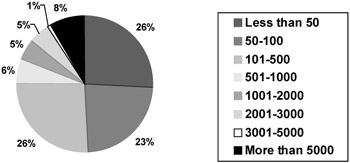Profile of Organizations
|
| < Day Day Up > |
|
The majority of the companies use multiple sales channels to sell their products with only 11.5% selling exclusively on the Internet. Other outlets used include retail outlets (70%), mail order (50%), and third party sellers (27%). The companies are export focused—37% have exports that account for in excess of 40% of their annual revenue.
The majority of companies have been in business for more than eight years (58.5%), with only 4% of companies being in business for less than one year. The organizations surveyed are early adopters of e-business within their industry—only 17% believe that their competitors adopted e-business before them. In addition, the majority developed a website on their own initiative and not as the result of any outside pressure. Not only have these firms adopted e-business, but the majority (81%), are also generating revenue directly through their website.
The main reasons for getting involved in e-business were to acquire new customers (93%), to gain international exposure (90%), to advertise (79%), to overcome the company's location disadvantage (60%), to provide on-line customer support (59%), to gain cost savings (41%) and to gather customer information (31%). As such, the main motivator for e-business adoption was as a sales mechanism rather than as a means to cut costs or improve business processes.
The expectations of companies with respect to sales and competitiveness have been realized for the majority of the companies. 79% believe it has created new business, 68% believe it gives them a competitive edge, 62% have increased their sales in export markets. With respect to cost savings and business process improvements, only 39% believe that e-business speeds up the delivery of their product and 35% believe that it has resulted in substantial cost saving.
The use of e-business is changing the industry structure within which these firms operate. Firstly, it is increasing competition within the industry (only 17% believe it is not), and, secondly, it is giving rise to dis-intermediation—40% have cut out intermediaries in the sales process and e-business has allowed 84% of companies to sell directly to their final customers.
Metrics of Success
Seventy-five percent (75%) of firms are repceiving between one and 500 hits to their website per week, (with 26% receiving less than 50 hits per week, 26% receiving between 101–500 hits per week and the remaining 23% receiving between 50–100) (Figure 1). Of the 25% who received more than 500 hits per week, 8% receive more than 5,000 hits per week. Nearly half of the respondents (49%) generated 1–20% of their sales leads as a result of the website, while a further 12% obtained 21–40% of sales leads as a result of the website (Table 1). Another 21% of companies attain anywhere between 41% and 100% of sales leads as a result of their Internet presence. However, 17% of respondents thought that the website generated none of their sales leads.
| % of Sales Leads Generated from Website | % of Companies |
|---|---|
| 0% | 17% |
| 1–20% | 49% |
| 21–40% | 12% |
| 41–60% | 6% |
| 61–80% | 3% |
| 81–100% | 6% |
| Don't Know | 7% |

Figure 1: Number of Hits Per Week
The third measure of success is revenue generated by the website. A small percentage of firms (8%) are generating between 81–100% of their revenue from the website (Figure 2). A further 9% are generating between 21% and 80% of revenues from their website. However, most companies (64%) are only generating between 1% and 20% of revenues from the website. Despite these promising figures, a further 20% of companies are generating no revenue at all from their website.

Figure 2: Percent of Annual Revenues Generated by Website
|
| < Day Day Up > |
|
EAN: 2147483647
Pages: 191